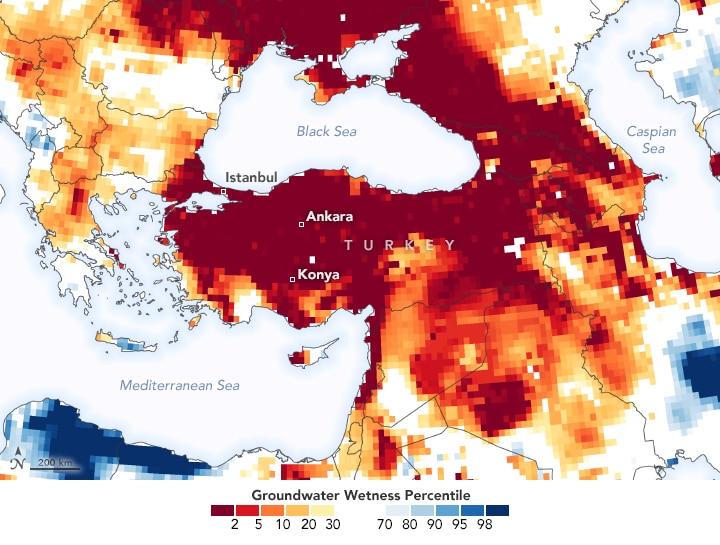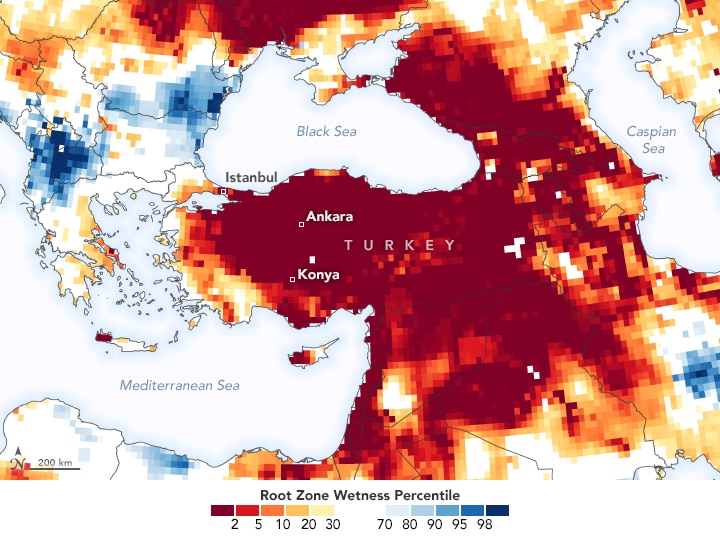Images captured by NASA’s GRACE-FO satellite on January 11th show the severity of the lack of rainfall and subsequent drought in Turkey this past year.
—
2020 was Turkey’s driest year since 2015, with nearly all provinces receiving below average rainfall since July, and the average rainfall between October and December half of the average between 1981-2010.

Source: NASA Earth Observatory.
This drought comes off the heels of another in 2019 when it barely rained in the Summer and Autumn months. These prolonged droughts have placed increased stress on the nation’s aquifers which have been severely depleted.
In the map below, NASA’s Gravity Recovery and Climate Experiment Follow On (GRACE-FO) satellites, which measure shallow groundwater storage on Earth, show the severity of Turkey’s current drought as of January 11th, 2021. The orange and red areas signal below average groundwater content, while areas in blue indicate above average groundwater content.
Almost all of Turkey’s land surface is critically depleted of groundwater, raising concerns regarding agriculture and drinking water supply.
Another image from NASA’s GRACE-FO shows the soil moisture in the root zone (top meter of soil) which is a vital source of water for crops. The image again shows most of Turkey’s surface area in a deep shade of red, indicating that most of the country’s root soil is severely dry.

Source: NASA Earth Observatory.
Crop yields have been impacted by the excessively dry soil, with the regions of Konya plain in the south and Edirne province in the north particularly affected. Murat Akbulut, head of the Konya Chamber of Agricultural Engineers, says a 10% loss in crops for 2021 is inevitable. Most farmers are forced to divert water from nearby rivers or local aquifers, although the luckier ones have access to a large irrigation system called the Blue Tunnel, installed in 2015.
Aquifers, while a vital source of water to nations in hot and arid climates such as Turkey, are not a sustainable long-term solution. They refill through the slow drip of water seepage through the ground, meaning they can’t replenish anywhere near the same speed they are extracted upon, especially in times of drought. Further, once underground pockets are emptied, they collapse upon themselves and cannot be refilled; this is what causes land subsidence.
How are the people faring? Istanbul, Turkey’s megacity capital home to 17 million people, was warned on January 13th that they had less than 45 days of water left as the water level in seven of their surrounding reservoirs dipped below 25%, less than half the rate of the same time last year. If no significant rainfalls occur, the city is expected to run out of water by the end of February.
Dry spells in Turkey have been common since the late 1980s as a result of global climate changes, says Dr Akgün İlhan a water management expert. However, Dr. İlhan explains that the severity of the current problem is more so the result of “a lack of adaptation or even maladaptation to climate change.” For instance, the lack of green space in cities stops water that falls there to reenter aquifers.
The focus now is on reducing water waste and consumption and improving efficiency. The Turkish government is hoping to implement a water action plan early this year, focused on building 150 underground dams, constructing an underground irrigation system designed to be 40% more efficient than current methods, and repairing the old pipes currently causing water wastage.
This article was written by Lola Robinson.
You might also like: NASA Imagery: Louisiana is Losing its Coastline
References
-
Patal , Kasha. “Turkey Experiences Intense Drought.” NASA, NASA, 16 Jan. 2021, https://earthobservatory.nasa.gov
-
McKernan, Bethan. “Turkey Drought: Istanbul Could Run out of Water in 45 Days.” The Guardian, 2021, www.theguardian.com
-
Ateş, Hazal. “Turkey’s Action Plan to Fight Drought Focuses on Saving Water Sources.” Daily Sabah, Daily Sabah, 14 Dec. 2020, www.dailysabah.com
-
Dartford, Katy. “Turkey Faces Its Most Severe Drought in a Decade.” Euronews, 14 Jan. 2021, www.euronews.com
-
“Drought Threat Looms over Turkey as Dams Dry up – Turkey News.” Hürriyet Daily News, 7 Jan. 2021, www.hurriyetdailynews.com
-
“Severe Drought in Turkey: Istanbul Can Run out of Water in Months.” Down To Earth, 19 Jan. 2021, www.downtoearth.org












![The Statistics of Biodiversity Loss [2020 WWF Report]](https://earth.org/wp-content/uploads/2020/12/lprwinkyTHB-544x306.jpg)





